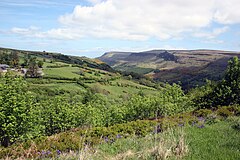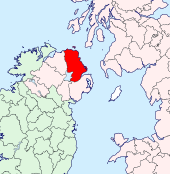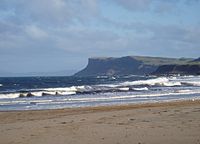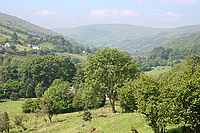County Antrim
| County Antrim United Kingdom | |
 Glenariff | |
|---|---|

| |
| [Interactive map] | |
| Area: | 1,175 square miles |
| Population: | 615,701 |
| County seat: | Belfast |
| Biggest town: | Belfast - partly in Downshire |
| County flower: | [1] |
The County of Antrim is a shire on Ulster's north-eastern coast. It is bounded almost all round by water; the sea to the north and east, Lough Neagh and the River Bann to the west, and the River Lagan in the south. Antrim is the most populous county in Northern Ireland.
Antrim is also famed for natural treasures; the Glens of Antrim in the northeast of the county offer isolated rugged landscapes, while the Giant's Causeway on the north coast is a unique landscape and a UNESCO World Heritage site. Nearby Portrush has developed as a popular seaside resort.
Contents
About the county
The county's greatest town is Belfast, the county town and Northern Ireland's capital. Two of Northern Ireland's main ports are in County Antrim; Larne and Belfast. From Larne sail ferries for Cairnryan, Troon and Fleetwood, while the Port of Belfast, receiving over 6,000 vessels each year, is Ulster's principal maritime gateway, handling some two thirds of Northern Ireland's seaborne trade, and a quarter of that for the island of Ireland as a whole.[1]
Antrim's southeast, in and around Belfast, is a major centre of industry and commerce.
Landscape
A large portion of Antrim is hilly, especially in the east, where the highest elevations are attained. The range runs north and south, and, following this direction the highest points are Knocklayd (1,695 feet), Slieveanorra (1,676 feet), Trostan (1,817 feet), Slemish (1,457 feet) and Divis (1,567 feet). The inland slope is gradual, but on the northern shore the range terminates in abrupt and almost perpendicular declivities, and here, consequently, some of the finest coast scenery in the world is found, widely differing, with its unbroken lines of cliffs, from the indented coast-line of the west. The most remarkable cliffs are those formed of perpendicular basaltic columns, extending for many miles, and most strikingly displayed in Fair Head and the celebrated Giant's Causeway.
From the eastern coast the hills rise instantly but less abruptly, and the indentations are wider and deeper. On both coasts there are several resort towns, including Portrush (with well-known golf links), Portballintrae and Ballycastle; on the east Cushendun, Cushendall and Waterfoot on Red Bay, Carnlough and Glenarm, Larne on the North Channel, and Whitehead on Belfast Lough. All are somewhat exposed to the easterly winds prevalent in spring.
The only island of size is Rathlin Island, off Ballycastle, 6½ miles in length by 1½ in breadth, 7 miles from the coast, and of similar basaltic and limestone formation to that of the mainland. It is partially arable, and supports a small population. Islandmagee is a peninsula separating Larne Lough from the North Channel.
The valleys of the Bann and Lagan, with the intervening shores of Lough Neagh, form the fertile lowlands. These two rivers, both rising in County Down, are the only ones of importance. The latter flows to Belfast Lough, the former drains Lough Neagh, which is fed by a number of smaller streams. The fisheries of the Bann and of Lough Neagh (especially for salmon and eels) are of value both commercially and to sportsmen, the small town of Toome, at the outflow of the river, being the centre. Immediately below this point lies Lough Beg, the "Small Lake," about fifteen feet lower than Lough Neagh.
Glens of Antrim
- Main article: Glens of Antrim
Antrim is famed for the Nine Glens of Antrim, which run from high in the hills of the Antrim Plateau down to the sea on the county's eastern coast. The two northerly glens reach north to the north coast and the others run eastward almost parallel to one another, all stretching over 20 miles from the northernmost to the southernmost:
The Glens are designated part of the Antrim Coast and Glens area of outstanding natural beauty and are a major tourist attraction in north Antrim.
The Lordship of the Glens, from the mid-13th century, first belonged to the Scoto-Irish Norman Bissett family. In the mid-16th century it came into the possession of the MacDonnells of Antrim, a branch of the Hebridean clan, the McDonalds.
The nine glens from northernmost to southernmost are:
Glenravel may be considered a tenth glen, although it does not open directly onto the sea but lies to the southwest of Glenballyeamon and Glenariff, separated by the Glenariff forest park.
Towns and villages
Large towns
- Antrim
- City of Belfast (partly in Downshire)
- Ballymena
- Carrickfergus
- Larne
- City of Lisburn (partly in Downshire)
- Newtownabbey
Smaller towns
- Ballycastle
- Ballyclare
- Ballymoney
- Greenisland
- Jordanstown
- Portrush (partly in County Londonderry)
- Randalstown
Parishes
- Aghagallon
- Aghalee
- Ahoghill
- Antrim
- Ardclinis
- Armoy
- Ballinderry
- Ballintoy
- Ballyclug
- Ballycor
- Ballylinny
- Ballymartin
- Ballymoney*
- Ballynure
- Billy
- Camlin
- Carncastle
- Carnmoney
- Carrickfergus or St Nicholas'
- Connor
- Craigs
- Cranfield
- Culfeightrin
- Derryaghy
- Derrykeighan
- Donegore
- Drummaul
- Dunaghy
- Duneane
- Dunluce
- Finvoy
- Glenavy
- Glenwhirry
- Glynn
- Grange of Scullion*
- Grange of Doagh
- Grange of Drumtullagh
- Grange of Dundermot
- Grange of Inispollan
- Grange of Killyglen
- Grange of Layd
- Grange of Muckamore
- Grange of Nilteen
- Grange of Shilvodan
- Inver
- Island Magee
- Kilbride
- Killagan
- Killead
- Kilraghts
- Kilroot
- Kilwaughter
- Kirkinriola
- Lambeg†
- Larne
- Layd
- Loughguile
- Magheragall
- Magheramesk
- Newtown Cromellin
- Portglenone
- Racavan
- Raloo
- Romoan
- Rasharkin
- Rashee
- Rathlin Island
- Shankill
- Skerry
- Templecorran
- Templepatrick
- Tickmacrevan
- Tullyrusk
*: Extends into County Londonderry.
†: Extends into County Down.
‡: Extends into County Londonderry.
Additionally parts of the parishes of Ballyrashane, Ballyscullion, Ballywillin, Blaris, Drumbeg and Kildollagh extend into County Antrim.
Baronies
The Baronies of County Antrim are:
| Antrim Lower | Cary | Kilconway |
| Antrim Upper | Dunluce Lower | Massereene Lower |
| Belfast Lower | Dunluce Upper | Massereene Upper |
| Belfast Upper | Glenarm Lower | Toome Lower |
| Carrickfergus | Glenarm Upper | Toome Upper |
Notwithstanding the descent of most of Antrim's population from Scots and English settlers, the names of the townlands in the county are almost all of Gaelic derivation.
History
At what date the county of Antrim was formed is not known, but it appears that a certain district bore this name before the reign of Edward II (early 14th century), and when the shiring of Ulster was undertaken by Sir John Perrot in the 16th century, Antrim and Down were already recognized divisions, unlike the rest of the province.
The earliest known inhabitants were mesolithic hunter-gatherers,[2] a lost population.
In ancient times, Antrim was inhabited by a Celtic people called the Darini.[3] In the early Middle Ages, southern County Antrim was part of the Kingdom of Ulster, ruled by the Dál Fiatach clans Keenan and MacDonlevy/McDunlavey; the north was part of Dalriada, which stretched into what is now western Scotland over the Irish Sea. Dál Riada was ruled by the O'Lynch clan, who were vassals of the Ulaid. Besides the Ulaid and Dál Riada, there were the Dál nAraide of lower County Antrim, and the Cruthin, not Gaels and believed to be the same people as the Picts of Britain.[4]
Saint Patrick
Slemish, the hill about eight miles east of Ballymena, is notable for the woeful scene of St Patrick's early life. According to tradition, Patrick carried away to Ireland as a boy and was worked as a slave for seven years near the hill of Slemish, until he escaped back to Great Britain.
Vikings
Between the 8th and 11th centuries Antrim was exposed to the inroads of the Vikings.
Until the Plantation
In the late 12th century Antrim became part of the Earldom of Ulster, conquered by Anglo-Norman adventurers. A revival of Gaelic power followed the campaign in 1315 of Edward Bruce (son of Robert I of Scotland), leaving Carrickfergus alone as the only significant English stronghold. In the late Middle Ages, Antrim was divided into three parts: northern Clandeboye, the Glynnes and the Route. The Cambro-Norman MacQuillans were powerful in the Route. A branch of the O'Neills of Tyrone migrated to Clandeboye in the 14th century, and ruled it for a time. Their family was called O'Neill Clannaboy.
In the 15th century a new power arose: the MacDonnells. The MacDonnells were a sept of the famous McDonalds of the Hebrides, Lords of the Isles until displaced by James IV. To spread from the isles to Ulster was no great step, but soon they were became the most powerful in the Glynnes, though the marriage of Iain Mhoir Tanistear Mac Dòmhnaill to Margaret Bisset, a daughter of the Anglo-Norman lord of the Glynns or Glens. More McDonalds migrated to the Glynns and Rathlin and soon the lordship was theirs.
The most famous McDonnell was Sorley Boy, Somhairle Buidhe MacDonnell, who variously fought alongside and against the forces of Queen Elizabeth I. The story of Elizabethan Ulster is largely told in the shifting contest and alliances of Sorley Boy of Antrim and the O'Neills, in which ultimately the Crown and the MacDonnells were victorious. The Clan Donald were permitted to remain in Ulster and in possession of their gains, their seat at the dramatic Dunluce Castle on Antrim's north coast. Today's Earl of Antrim is a descendant of Sorley Boy McDonnell.
Clans and septs before the Plantation
Antrim is divided into sixteen baronies. Lower Antrim, part of Lower Clandeboye, was settled by the sept O'Flynn/O'Lynn. Upper Antrim, part of Lower Clandeboye, was the home of the O'Keevans. Belfast was part of Lower Clandeboye and was held by the O'Neill-Clannaboys. Lower Belfast, Upper Belfast, and Carrickfergus were also part of Lower Clandeboye. Cary was part of the Glynnes; ruled originally by the O'Quinn sept, the MacDonnell galloglasses from Scotland took power here in the late Middle Ages and some of the O'Haras also migrated from Connaught. Upper and Lower Dunluce were part of the Route, and were ruled by the MacQuillans. Upper and Lower Glenarm was ruled by the O'Flynn/O'Lynn sept, considered part of the Glynns.
The Scottish septs of MacKeown, MacAlister, and MacGee, are found in the Glens too. Kilconway was originally O'Flynn/O'Lynn territory, but was held by the MacQuillans as part of the Route, and later by the Scottish sept of MacNeill. Lower Massereene was part of Lower Clandeboye and was ruled by the O'Flynns and the O'Heircs. Upper Massereene was part of Lower Clandeboye, ruled by the O'Heircs. Upper and Lower Toome, part of the Route, were O'Flynn/O'Lynn territory. Misc was first ruled by the MacQuillans. Later, the Scottish Gallowglass MacDonnells and MacAlisters invaded. The MacDonnells were a branch of the Scottish Clan MacDonald. Like the McDonalds, the MacAlisters claimed to trace traced their origin back to the Irish Colla Uais.
Plantation
During the Tudor era, numerous adventurers from Britain attempted to colonize the region. Many Scots settled in Antrim around this time.[5] In 1588 the Antrim coast was the scene of one of the 24 wrecks of the Spanish Armada in Ireland. The Spanish vessel La Girona was wrecked off Lacana Point, Giant's Causeway in 1588 with the loss of nearly 1,300 lives.[6]
The major settlement of Antrim came under King James I and VI. Antrim was not officially designated a plantation county, but along with neighbouring Downshire it was heavily settled from Scotland and England. Modern Antrim can be traced from those settlers, whose descendants are by far the dominant population today.
Islandmagee had, besides antiquarian remains, a notoriety as a home of witchcraft, and during the Irish Rebellion of 1641 was the scene of an act of reprisal (for the massacre of Protestants) against the Roman Catholic population by the Scottish Covenanter soldiery of Carrickfergus.
The effect of the incoming population was dramatic: new towns and villages grew up in the countryside and on the coast and new roads were driven across the shire, and the old pattern of the countryside was taken in hand and rendered into farms on the English pattern, as it is seen today.
Industry: linen and ships
Linen manufacture was previously an important industry in the County. At the time Ireland produced a large mount of flax. Cotton-spinning by jennies was first introduced by to Belfast by industrialists Robert Joy and Thomas M'Cabe in 1777; twenty-three years later it was estimated that more than 27,000 people were employed in the industry within ten miles of Belfast. Women were employed in the working of patterns on muslin.
In the nineteenth century, Belfast became an industrial giant. The sheltered waters of Carrickfergus Lough, soon to be come known as Belfast Lough, allowed this once disregarded town to grow as the major port of Ulster and as a shipbuilding centre which would soon grown almost to rival Glasgow, its sea-neighbour. Belfast grew as an organic whole, obliterating the villages which had once stood where its new growths would appear. Immigration to the city, from Great Britain and more importantly from rural Ireland, changed the social nature of this corner of Antrim much as the industry had changed its physical nature.
Sights of County Antrim
Historic monuments
Physical beauties of the landscape abound. The antiquities of the county consist of cairns, mounts or forts, remains of ecclesiastical and military structures, and round towers, while many more modern buildings are equally worthy to vie for attention.
| Key | |
| |
Cathedral/Abbey/Priory |
| |
Accessible open space |
| |
Amusement/Theme Park |
| |
Castle |
| |
Country Park |
| |
State Care |
| |
Forestry Commission |
| |
Heritage railway |
| |
Historic House |
| |
Museum (free/not free) |
| |
National Trust |
| |
Zoo |
Natural wonders
- Giant's Causeway
- The Glens of Antrim
- Antrim Coast Road
- Glenariff Forest Park
- Carnfunnock Country Park
- Slemish
- Lough Neagh
Man-made sites
- Round towers: Antrim, Armoy and on Ram's Island in Lough Neagh
 Abbeys and church ruins: Bonamargy (where the Earls of Antrim are buried), Kells, Glenarm, Glynn, Muckamore and Whiteabbey.
Abbeys and church ruins: Bonamargy (where the Earls of Antrim are buried), Kells, Glenarm, Glynn, Muckamore and Whiteabbey. Castles:
Castles:
- Carrickfergus Castle, dating from the Norman invasion and one of the best preserved mediæval structures in Ireland.
- Dunluce Castle, on its dramatic location on a rocky cliftop
- Olderfleet Castle
- Shane's Castle
- Garron Tower
- Red Bay Castle Ruined seat of the Bissets and MacDonnells
 Glenarm Castle – seat of the Earl of Antrim
Glenarm Castle – seat of the Earl of Antrim Carrick-a-Rede rope bridge
Carrick-a-Rede rope bridge- Cromlechs: Cairngrainey (NE of the old Belfast road), Mount Druid (near Ballintoy), Islandmagee (northern headland)
 Whitehead Excursion Station
Whitehead Excursion Station- Old Bushmills Distillery
- Benvarden Garden, Dervock
- Andrew Jackson Centre, Boneybefore
Outside links
- County Antrim in 1900
- The Northern Ireland Guide: For information and reviews for locals and tourists alike
- Glens of Antrim Website
- Glens of Antrim Historical Society
References
- ↑ Port of Belfast
- ↑ Waddell, John (1998). The Prehistoric Archaeology of Ireland. Galway: Galway University Press Limited. pp. 11–24.
- ↑ O'Rahilly, Thomas F. (1946). Early Irish History and Mythology. Dublin: Dublin Institute for Advanced Studies. p. 7.
- ↑ O'Rahilly, Thomas F. (1946). Early Irish History and Mythology. Dublin: Dublin Institute for Advanced Studies. pp. 341–352.
- ↑ Benn, George (1877). A History of the Town of Belfast. Belfast: Marcus Ward & Company. pp. 21 ff..; Encyclopaedia Britannica (14th edition), Antrim.
- ↑ "La Girona" (PDF). # Annual Report of the Advisory Committee on Historic Wrecks, 2005. Advisory Committee on Historic Wreck Sites. pp. 35. http://www.english-heritage.org.uk/upload/pdf/ACHWS_annual_report_2005.pdf. Retrieved 2008-11-01.
| Counties of the United Kingdom |
|---|
|
Aberdeen • Anglesey • Angus • Antrim • Argyll • Armagh • Ayr • Banff • Bedford • Berks • Berwick • Brecknock • Buckingham • Bute • Caernarfon • Caithness • Cambridge • Cardigan • Carmarthen • Chester • Clackmannan • Cornwall • Cromarty • Cumberland • Denbigh • Derby • Devon • Dorset • Down • Dumfries • Dunbarton • Durham • East Lothian • Essex • Fermanagh • Fife • Flint • Glamorgan • Gloucester • Hants • Hereford • Hertford • Huntingdon • Inverness • Kent • Kincardine • Kinross • Kirkcudbright • Lanark • Lancaster • Leicester • Lincoln • Londonderry • Merioneth • Middlesex • Midlothian • Monmouth • Montgomery • Moray • Nairn • Norfolk • Northampton • Northumberland • Nottingham • Orkney • Oxford • Peebles • Pembroke • Perth • Radnor • Renfrew • Ross • Roxburgh • Rutland • Selkirk • Shetland • Salop • Somerset • Stafford • Stirling • Suffolk • Surrey • Sussex • Sutherland • Tyrone • Warwick • West Lothian • Westmorland • Wigtown • Wilts • Worcester • York |










